You have no items in your shopping cart.
| Catalog Number | orb6452 |
|---|---|
| Category | Antibodies |
| Description | Phospho-mTOR (Ser2448) Rabbit Polyclonal Antibody |
| Species/Host | Rabbit |
| Clonality | Polyclonal |
| Tested applications | FC, IF, IHC-Fr, IHC-P |
| Predicted Reactivity | Bovine, Canine, Equine, Rabbit, Sheep |
| Reactivity | Human, Mouse, Rat |
| Isotype | IgG |
| Immunogen | KLH conjugated Synthesised phosphopeptide derived from human mTOR around the phosphorylation site of Ser2448 TD(p-S)YS |
| Concentration | 1mg/ml |
| Dilution range | IHC-P=1:100-500, IHC-F=1:100-500, IF=1:100-500, Flow-Cyt=1μg /test |
| Form/Appearance | Liquid |
| Conjugation | Unconjugated |
| MW | 289 kDa |
| Target | MTOR |
| UniProt ID | P42345 |
| RRID | AB_10938852 |
| Storage | Maintain refrigerated at 2-8°C for up to 2 weeks. For long term storage store at -20°C in small aliquots to prevent freeze-thaw cycles. |
| Buffer/Preservatives | 0.01M TBS (pH7.4) with 1% rAlbumin, 0.02% Proclin300 and 50% Glycerol. |
| Alternative names | mTOR (phospho S2448); p-mTOR (phospho S2448); Phos Read more... |
| Note | For research use only |
| Expiration Date | 12 months from date of receipt. |
Qiu, Jingping et al. Distinct subgroup of the Ras family member 3 (DIRAS3) expression impairs metastasis and induces autophagy of gastric cancer cells in mice J Cancer Res Clin Oncol, 144, 1869-1886 (2018)

Blank control (blue line): Hela (fixed with 70% ethanol (Overnight at 4°C) and then permeabilized with 90% ice-cold methanol for 30 min on ice), Primary Antibody (green line): Rabbit Anti-Phospho-mTOR (Ser2448) antibody (orb6452), dilution: 1 µg/10^6 cells. Isotype Control Antibody (orange line): Rabbit IgG. Secondary Antibody (white blue line): Goat anti-rabbit IgG-FITC, dilution: 1 µg/Test.
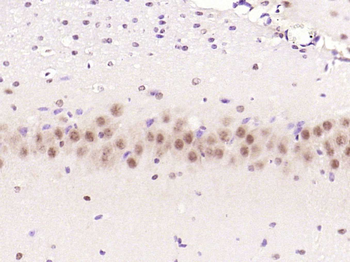
Paraformaldehyde-fixed, paraffin embedded (mouse brain), Antigen retrieval by boiling in sodium citrate buffer (pH6.0) for 15 min, Block endogenous peroxidase by 3% hydrogen peroxide for 20 minutes, Blocking buffer (normal goat serum) at 37°C for 30 min, Antibody incubation with (Phospho-mTOR (Ser2448)) Polyclonal Antibody, Unconjugated (orb6452) at 1:200 overnight at 4°C, followed by operating according to SP Kit (Rabbit) instructionsand DAB staining.
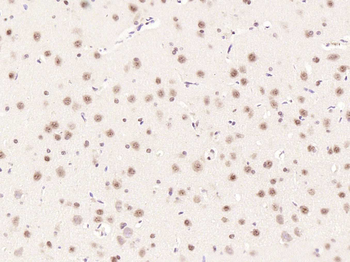
Paraformaldehyde-fixed, paraffin embedded (rat brain), Antigen retrieval by boiling in sodium citrate buffer (pH6.0) for 15 min, Block endogenous peroxidase by 3% hydrogen peroxide for 20 minutes, Blocking buffer (normal goat serum) at 37°C for 30 min, Antibody incubation with (Phospho-mTOR (Ser2448)) Polyclonal Antibody, Unconjugated (orb6452) at 1:200 overnight at 4°C, followed by operating according to SP Kit (Rabbit) instructionsand DAB staining.
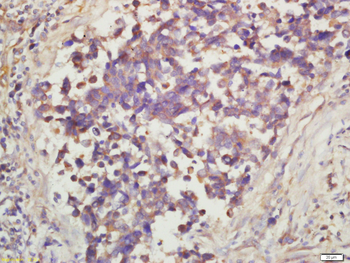
Tissue/Cell: human lung carcinoma, 4% Paraformaldehyde-fixed and paraffin-embedded, Antigen retrieval: citrate buffer (0.01M, pH6.0), Boiling bathing for 15 min, Block endogenous peroxidase by 3% Hydrogen peroxide for 30 min, Blocking buffer (normal goat serum) at 37°C for 20 min, Incubation: Anti-Phospho-mTOR (Ser2448) Polyclonal Antibody, Unconjugated (orb6452) 1:200, overnight at 4°C, followed by conjugation to the secondary antibody and DAB staining.
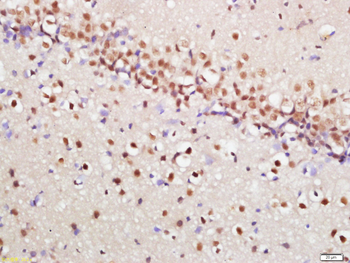
Tissue/Cell: Rat brain tissue, 4% Paraformaldehyde-fixed and paraffin-embedded, Antigen retrieval: citrate buffer (0.01M, pH6.0), Boiling bathing for 15 min, Block endogenous peroxidase by 3% Hydrogen peroxide for 30 min, Blocking buffer (normal goat serum) at 37°C for 20 min, Incubation: Anti-phospho-mTOR Polyclonal Antibody, Unconjugated (orb6452) 1:200, overnight at 4°C, followed by conjugation to the secondary antibody and DAB staining.
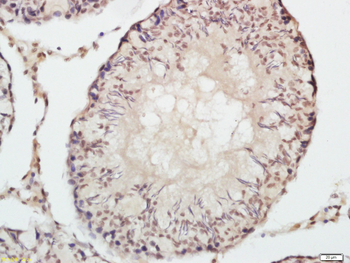
Tissue/Cell: Rat testis tissue, 4% Paraformaldehyde-fixed and paraffin-embedded, Antigen retrieval: citrate buffer (0.01M, pH6.0), Boiling bathing for 15 min, Block endogenous peroxidase by 3% Hydrogen peroxide for 30 min, Blocking buffer (normal goat serum) at 37°C for 20 min, Incubation: Anti-phospho-mTOR Polyclonal Antibody, Unconjugated (orb6452) 1:200, overnight at 4°C, followed by conjugation to the secondary antibody and DAB staining.
Phospho-mTOR (Ser2448) Rabbit Polyclonal Antibody (PE-Cy5) [orb885842]
FC, IF
Bovine, Canine, Equine, Rabbit, Sheep
Human, Mouse, Rat
Rabbit
Polyclonal
PE/Cy5
100 μlPhospho-mTOR (Ser2448) Rabbit Polyclonal Antibody (BF750) [orb1584738]
FC, IF
Bovine, Canine, Equine, Rabbit, Sheep
Human, Mouse, Rat
Rabbit
Polyclonal
BF750
100 μlPhospho-mTOR (Ser2448) Rabbit Polyclonal Antibody (BF680) [orb1584739]
FC, IF
Bovine, Canine, Equine, Rabbit, Sheep
Human, Mouse, Rat
Rabbit
Polyclonal
BF680
100 μlPhospho-mTOR (Ser2448) Rabbit Polyclonal Antibody (BF647) [orb1584740]
FC, IF
Bovine, Canine, Equine, Rabbit, Sheep
Human, Mouse, Rat
Rabbit
Polyclonal
BF647
100 μlPhospho-mTOR (Ser2448) Rabbit Polyclonal Antibody (BF594) [orb1584741]
FC, IF
Bovine, Canine, Equine, Rabbit, Sheep
Human, Mouse, Rat
Rabbit
Polyclonal
BF594
100 μl



